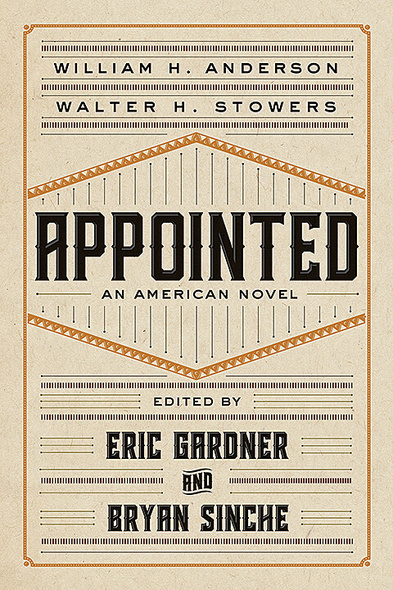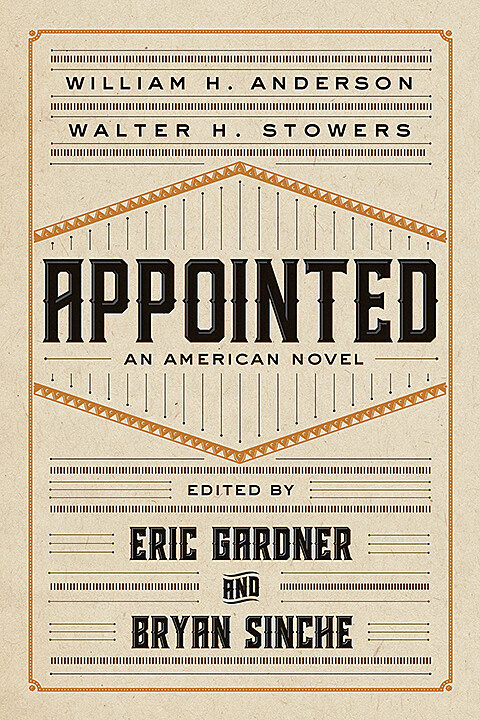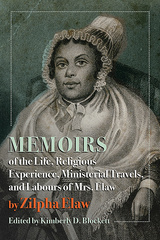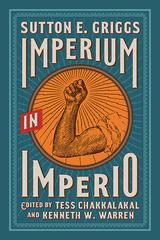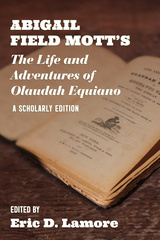Appointed is a recently recovered novel written by William Anderson and Walter Stowers, two of the editors of the Detroit Plaindealer, a long-running and well-regarded African American newspaper of the late nineteenth century. Drawing heavily on nineteenth-century print culture, the authors tell the story of John Saunders, a college-educated black man living and working in Detroit. Through a bizarre set of circumstances, Saunders befriends his white employer’s son, Seth Stanley, and the two men form a lasting, cross-racial bond that leads them to travel together to the American South. On their journey, John shows Seth the harsh realities of American racism and instructs him in how he might take responsibility for alleviating the effects of racism in his own home and in the white world broadly.
As a coauthored novel of frustrated ambition, cross-racial friendship, and the tragedy of lynching, Appointed represents a unique contribution to African American literary history. This is the first scholarly edition of Appointed, and it includes a collection of writings from the Plaindealer, the authors’ short story “A Strange Freak of Fate,” and an introduction that locates Appointed and its authors within the journalistic and literary currents of the United States in the late nineteenth century.
An admirable edition that will certainly find its way into courses on African American literature, and American literature more broadly. Gardner and Sinche have provided exceptional accompanying material that recovers not only the novel but also its makers and its contexts, and have included supplementary works that are well suited for classroom use.’
Benjamin Fagan, author of The Black Newspaper and the Chosen Nation
Eric Gardner is a professor of English at Saginaw Valley State University and award-winning author of Unexpected Places: Relocating Nineteenth-Century African American Literature and Black Print Unbound: The Christian Recorder, African American Literature, and Periodical Culture.
Bryan Sinche is associate professor and chair of English and modern languages at the University of Hartford. He has published over a dozen articles on nineteenth-century American literature and culture and is the editor of the teacher’s guide accompanying the Norton Anthology of African American Literature.
Introduction
“Sanda” and “John Saunders”
William Anderson (1857–1916) and Walter Haslip Stowers (1859–1932)—collectively “Sanda,” the pseudonym listed on the title page of Appointed: An American Novel—may never have known a figure like the main character of their 1894 novel. Late in the text after growing more and more awake to the racism woven into the very fibers of the United States, the white Seth Stanley is named—by his dying African American friend John Saunders—the “appointed” to help lead the fight against white supremacy. Stanley pledges himself to battle “to aid in clearing our country from its false ideas” and to work for broad civil rights (350). Imperfect though he is, Stanley would have nonetheless been an immense rarity in the 1890s.
But John Saunders embodied facets not only of many of Anderson and Stowers’s friends and acquaintances but also of the authors themselves.1 Like Saunders, both Anderson and Stowers had family roots in the South. Passing through Kentucky on a train, Saunders tells Stanley that the “tenderness and pleasure” at seeing where his parents were born is an act “mingled with horror and sorrow” at the “remorseless curse” of slavery and ongoing racism (232). Anderson’s parents—Richard and Mary Lott Anderson—were similar to many African Americans in the Midwest. Anderson’s mother’s family had lived in Indiana for at least two generations, but his father had been born in Kentucky. (Anderson himself had been born and raised in Sandusky, Ohio, before moving to Detroit as a teenager.) Stowers’s family history looks more like Saunders’s. Different sources place his birth in Kentucky, Ontario, or Michigan, in part because his Kentucky-born parents (Jesse and Hester Stowers) fled from the racist South and slave power to Ontario and then eventually settled in Detroit.
Like Saunders, both Anderson and Stowers were graduates of Detroit’s city high school (classes of 1875 and 1879, respectively). Like Saunders, Anderson worked in a department store (Newcomb, Endicott, and Company) after graduating, initially as a porter and eventually as a bookkeeper. Stowers spent seven years after high school as a clerk with Charles Root’s dry goods store. And like Saunders, Anderson and Stowers were “strivers”—part of a small but growing group of urban African Americans fighting to enter the middle class via education, business, and community engagement.
For Anderson and Stowers, that identity was masculinist, and it marked heterosexual marriage and family as crucial to community uplift. As much as Saunders describes his deep love for his fiancée Edith Darrow, she is also represented as a logical match, a true complement to Saunders. While he calls her “pretty”—and, in the sometimes-strange rhetoric of a pro-Black novel, light-skinned enough to pass “for a brunette” in a white family—he especially highlights the fact that “she is as refined and intelligent as anyone you have ever met and more accomplished than the majority” (209). She comes from one of Detroit’s “most prominent Afro-American families,” each member of which had proven themselves “energetic and unusually successful”; while her father began in the trades as a mason and contractor “by dint of economy and thrift,” he had “amassed considerable property” (214). Saunders’s impending marriage to Edith Darrow thus represents not only the culmination of a romantic love story but also, perhaps primarily, what Anderson and Stowers would characterize as a sensible alliance for the “good of the race”—one that would increase educational attainment (through their children) and property in Black Detroit. (Notably, Saunders tells Stanley that he has already purchased a lot and drawn plans for a house that he hopes to have completed before they wed.)
Anderson and Stowers were further down this path than their character, in part because they conceptualized Saunders as a bit younger and in part because they had moved more quickly into the world of work than Saunders did. In September 1885, Anderson married Lucy J. Bowdre (ca. 1861–1961), the daughter of George Washington and Ann Fox Bowdre,2 Georgia-born African Americans who had settled on a farm in Jefferson, Ohio. Like her husband, Lucy Bowdre Anderson worked for several years as a bookkeeper at Newcomb-Endicott, and, while the couple did not have children, was deeply active in Detroit community work at the end of the nineteenth century. Stowers married Susan F. Wallace (1859–1936, often listed as “Susie”), on February 23, 1886, in Lorain County, Ohio. Records on Wallace are much more scant, but most agree that she was born in Oberlin, Ohio, to parents from Virginia; her mother was likely Eliza Wallace, who was listed as Eliza Bell in Oberlin in 1870 (after marrying Walter Bell). Walter and Susie Stowers had two children, Marjorie (born in 1889) and Walter J. (born in 1895). Both the Anderson and Stowers families settled in Detroit’s Third Ward on Division Street, where they were next-door neighbors (50 Division and 44 Division, respectively) for more than a decade before prosperity and the gradual opening of housing possibilities—something Stowers would fight especially hard for later in his life—gave them broader options.
These differences in work, marital, and familial status between Anderson and Stowers highlight another key difference from John Saunders. While the fictional Saunders attended and graduated from the University of Michigan, only Stowers would attend college—initially a commercial college focused on book-keeping and business practice, Mayhew’s Business University—before eventually attending the Detroit College of Law and becoming one of that school’s first Black graduates.3 In Michigan in the 1880s, even that course was the exception for young African American men. African American students at the state’s flagship university were even more rare: while Samuel Codes Watson broke the color barrier to enroll in the medical department from 1853 to 1855, for example, it was not until John Summerfield Davidson and Gabriel Franklin Hargo enrolled in 1868 that the college saw more African American students. The first Black woman, Mary Henrietta Graham, was admitted in 1876, and only at the turn of the century did numbers reach levels high enough to see Black organizations on campus. In short, Anderson and Stowers gave their character John Saunders significant educational advantages, but must have keenly felt that, even with such advantages, many African Americans still faced decided barriers when trying to enter the professions.4 Thus, Saunders’s department store clerking is, in part, the result of the failure of white Detroit entities to allow him to practice in his field—civil engineering. As much as he embodies the rare gains made by a small group of African Americans in higher education at the end of the nineteenth century, Saunders also marks the continuing discrimination of the world of work, discrimination Anderson and Stowers knew well.
Nonetheless, like Saunders, Anderson and Stowers continued their educations outside of formal channels too. Both read widely and deeply and learned from a supportive Black community around them.5 That learning brought them quickly into an exciting moment in Black print culture. It was a moment when select Black newspapers like the African Methodist Episcopal Church Christian Recorder and more secular titles like the San Francisco Elevator had established both multiyear publication histories and significant Black audiences.6 It was a moment, as well, when African Americans were able to expand the slim points of entry into the print trades a bit more.7 And it was a moment when a growing Black reading public looked—sometimes desperately—for print material that spoke to their diverse experiences. Thus, Anderson and especially Stowers grew interested when, in 1879, Robert Pelham Jr. (1859–1943) and his brother Benjamin (1862–1948), both apprentice typesetters at the white-run Detroit Post-Tribune (where Benjamin had begun as a newsboy when the paper was the Detroit Post), began what can be best described in the tradition of late nineteenth-century amateur newspapers, an eight-page offering called the Venture. That paper, generally a monthly, was published somewhat spottily until 1882.
Joined by Byron G. Redmond (1860–1932), the Pelham brothers, Anderson, and Stowers formed a group of five, later christened the “Plaindealer Boys.” The five young men, all of whom had grown up in the midst of the Civil War and Reconstruction, keenly felt both the hopes of and the threats to African Americans in the mid-nineteenth century; they felt, as well, a deep sense of responsibility to their fellows. Recognizing education and participation in American print culture as central goals, in May 1883, they audaciously started their own weekly newspaper, the Plaindealer—a newspaper written and run by African Americans that was first and foremost for African Americans.8 They initially negotiated with the Post-Tribune9 to print the Plaindealer in their facilities, and later gained their own equipment and offices. While we know comparatively little about the paper’s initial years because issues published before 1889 have not been located, the paper quickly became a force. Plugging into the long Black convention movement, which had powerful roots in the antebellum “Colored Conventions,”10 the paper advocated strongly for the February 1884 Colored Men’s State Convention held at Battle Creek, and this work highlighted the editors’ increased presence in Republican party politics in both Detroit and the larger state. (Anderson would become a key player in the National Afro-American League, especially in the 1890s, and Stowers would later garner appointments as deputy sheriff of Wayne County and deputy county clerk.)
The paper expanded in size (at one point running twenty pages), garnered praise from the likes of Frederick Douglass, became a go-to source for white newspapers reporting on Black Detroit, gained a readership well beyond Detroit’s then-small Black community, and at times thought of itself as a regional paper with a national reach rather than just a city paper—including articles on and from, for example, the small Black community in East Saginaw, Michigan, a hundred miles to the north, as well as work from a regular correspondent in Washington, DC. The paper even had what was essentially a Cincinnati branch for a year in 1892, and ran, for a time, what it called a “monthly novel supplement” that reprinted popular novels of the period. The Plaindealer managed to survive for eleven years in a print landscape littered with failed periodical ventures, and the extensive extant run of issues between 1889 and 1893 begs for fuller study. Writing in his landmark 1891 The Afro-American Press and Its Editors, I. Garland Penn said the Plaindealer demonstrated that “with the proper business capacity and editorial ability,” Black periodicals “can be made most emphatically a success”; Penn called the editors “men of push and men of the hour.”11 Penn concluded that the paper was always “full of news,” with columns “teeming with bright editorials,” and so “will always be a welcome visitor to the home of every Afro-American.”12
When the paper finally folded, its editors had strong local and, among African Americans, national reputations. While financial difficulties certainly played a part in closing the paper, the Pelham brothers and Stowers became even more active in both local politics and civil service—endeavors that, like Anderson’s work with the National Afro-American League, took much time and energy.13 Appointed was published in the midst of this transitional moment.
Appointed in Context
Unfortunately, key documents surrounding Appointed—a manuscript of the novel, correspondence about (or first-person accounts of) its composition, materials relating to publication—have not yet come to light. This means that we cannot yet trace what seems both an exciting and comparatively rare phenomenon: the creative collaboration of two young African American men at the end of the nineteenth century to produce a novel.
We can say that the networks that Anderson and Stowers established during this period were essential to Appointed. The novel regularly quotes from (and even offers footnotes citing) both white and African American periodicals of the period. Such texts would have been readily available via the Plaindealer’s participation in the nineteenth-century practice of periodical exchange, in which a newspaper would send out copies of each issue to several other newspapers and, in turn, receive copies of those newspapers. Internal evidence strongly suggests that Anderson and Stowers may have been drafting the novel as early as the mid-1880s. Many of the stories and statistics that the novel includes appeared in newspapers between 1885 and 1890. Moreover, the novel mentions the massacre “last fall” of African Americans at Thibodaux, Louisiana, which happened in November 1887, and shows great interest in the 1888 presidential election (252).14 At the very least, Anderson and Stowers were using either a back file of periodicals they had created or perhaps a kind of scrapbook of clippings from such periodicals.
And it is crystal clear that the novel was a collaborative effort. While the novel’s title page carried the pseudonym “Sanda”—visually close to “Saunders,” but also a plausible condensation and joining of Stowers and Anderson—Anderson and Stowers were listed jointly on the book’s copyright page, ads referred potential buyers to Anderson by name, and contemporary notices listed both men as authors.15
Anderson and Stowers could not tap into a burgeoning market for African American novels or poetry in book form. When they wrote Appointed, there were comparatively few belletristic books by African Americans that had been published by major (or even minor) publishing houses, even though the Black press had begun publishing select serial novels by African American writers in the 1860s and had long been a central outlet for Black poetry.16 In the white-dominated world of bound books, the bestselling fictions about African Americans were those authored by white men writing in the deep racism of the “plantation tradition.” Thomas Nelson Page’s In Ole Virginia (1887) and Joel Chandler Harris’s Uncle Remus: His Songs and His Sayings (1880) circulated widely and attracted favorable reviews from white readers in the North and the South. If Anderson and Stowers wanted to publish their novel serially, they had a ready vehicle, but most of the serialized fiction printed by the Plaindealer was also authored by white men and women.17 Some African American authors looking to publish bound books chose to self-publish, a course pursued by the poets Albery A. Whitman and Islay Walden and the fiction writer James H. W. Howard.18
Anderson and Stowers chose this approach, but their version of self-/subsidized publication was especially interesting. The title page carries what looks like a publisher’s imprint: “Detroit: Detroit Law Printing Co., 47 Griswold St., 1894.” WorldCat lists no other imprints from this firm, and no directory we have examined includes it. Instead, 47 Griswold was, for several years prior to and after the publication of Appointed, the print shop of Joseph A. Topping. Topping was essentially a jobber—a printer of texts ranging from Charles Richmond Henderson’s 1890 pamphlet The Ascension of Christ and Lee McCollester’s 1892 sermon The American Citizen to the 1892 commemorative pamphlet for the Reunion [of] Battery I, 1st Michigan Light Artillery and the Detroit High School Scholarship Committee’s 1903 Twelve Years of Detroit High School Scholarship. In short, Anderson and Stowers seem to have created the “Detroit Law Printing Co.” specifically for the purpose of publishing Appointed, giving the novel what perhaps read as a boutique publishing imprint, one that notably carried the weight of “law” in its name—something especially fascinating, given the book’s attention to lynching and “lynch law.” Of course, “Detroit Law” carried a much more personal connection for Stowers, who was completing his course of study at the relatively young Detroit College of Law; Stowers might well have seen this as a stamp of his aspirations, as his practice of law would include significant civil rights work in Detroit fighting for causes noted in the novel.
Anderson and Stowers may also have wanted to join the number of texts of the 1880s and 1890s that treated the “color line.”19 They certainly seem to have thought that they could leverage personal, political, and press contacts in order to find buyers and readers. And, for the most part, what readers the men did find seemed impressed with the book. Even the New York–based Churchman, founded by white Episcopalian clergyman and entrepreneur George S. Mallory, which found it “all manifestly amateur work” and submitted that “author, printer, and publishers are evidently alike new at book-making,” noted “an earnestness in it and an honest desire to better an undoubtedly shameful condition of things.”20
The reviewer for the Cleveland Gazette was far more enthusiastic; he classed the book with “Judge [Albion] Tourgee’s splendid works” and appended a lengthy review from Tourgee himself that praised the book and urged its purchase by commanding readers to consider the words of “the calmest, most hopeful and self-respecting of the people we are insisting upon thrusting to one side and giving only the crumbs that fall from the table of civilization.”21 Writing in the Indianapolis Freeman, a reviewer noted Tourgee’s praise for Appointed and insisted that “T. Thomas Fortune . . . pronounced it the best book issued in 1894 by members of the race.”22 As quoted in an advertisement for the novel, Frederick Douglass called Appointed “a very good and timely book,” and the authors’ friend David Augustus Straker deemed it the “complement to Uncle Tom’s Cabin.”23 The novel also merited mention or more in the Leavenworth (KS) Herald, Parsons (KS) Weekly Blade, New York Independent, Richmond Planet, and Detroit News-Tribune, among others. Cleveland’s most famous Black author, Charles Chesnutt, probably read about the novel in his hometown Gazette; in 1896, he mentioned it to a correspondent as an example of “commendable efforts” in the “direction” of literature.24 Chesnutt’s perhaps tepid praise aside, the endorsements from Black newspapers and from Douglass, Tourgee, and Fortune situate Appointed at the very center of late nineteenth-century African American literary culture, and praise from such “leading men” suggests that they viewed Appointed as a meaningful contribution to the aesthetic and political goals of the moment.
It was published at a time when “the novel became an instrument of choice” in what Daylanne K. English calls a “literary-political struggle,” and it met that call.25 The novel focuses almost entirely on the Black middle class and the injustices that flow from a failure to recognize the equality of those Du Bois would call “the talented tenth”—the 10 percent of Black men who were, to Du Bois, “exceptional.”26 As one might expect given this focus, Appointed directs readers to hope for assimilation rather than revolution—and so is very different from Frances Ellen Watkins Harper’s novel Iola Leroy (1892). As Anderson and Stowers probe the potential for assimilation, they offer a window into relationships between Black and white people in the post–Civil War period and use that window to argue for changes running from the personal to the social to the political. And, like Iola Leroy, Charles Chesnutt’s The House Behind the Cedars (1900), Pauline Elizabeth Hopkins’s Contending Forces (1900), and James Weldon Johnson’s The Autobiography of an Ex-Colored Man (1912), Appointed uses romantic relationships between individuals to mirror the relationships between Black and white Americans, just as the authors later did in their short story “A Strange Freak of Fate,” which was published in the A. M. E. Church Review in 1897.27
Appointed is also notable both for its depiction of a white protagonist and his circle and for the ways it foregrounds the role of the African American press.28 By reworking the romance plot, Anderson and Stowers developed a new way to understand love, duty, and obligation in relation to race. Within that romantic framework, the authors mined the rich legacy of African American newspaper reporting to show the struggles and indignities attending Black life in the post-Reconstruction United States. Through a combination of romance and reportage, Anderson and Stowers created something unique and uniquely upsetting: a novel that illuminates the chasm between white ideals and Black experiences and, ultimately, underscores the sacrifices Black people make so white Americans can maintain their ideals. While assimilation may be the goal for Black characters in Appointed, the authors insist it is the national body into which those characters might be assimilated that is in dire need of rehabilitation.
Introduction
Note on the Text
Appointed: An American Novel
Appendix A: Reviews of Appointed
Appendix B: Writings from the Plaindealer
Appendix C: “A Strange Freak of Fate”
Notes
Bibliography of Related Works

